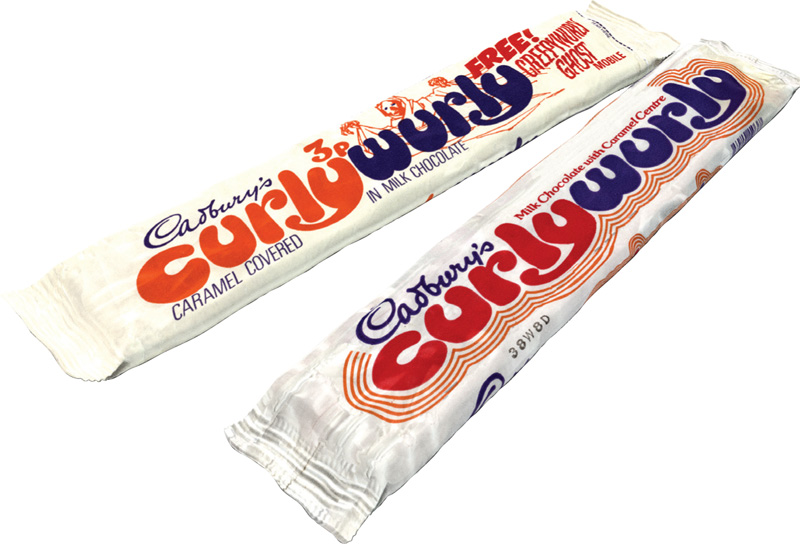
Cadbury’s make with the ‘miles of chewy toffee.’ Curly Wurly (1970).

Cadbury’s make with the ‘miles of chewy toffee.’ Curly Wurly (1970).
Cadbury entered the 1970s in a reflective mood. Mars was the problem. Mars’s big-hitters – filled bars in the Marathon, Mars or Milky Way mould – were cleaning up, while Cadbury’s sedate blocks were primarily successful with only the older, and significantly less impulsive, customer. No one bought and scoffed three bars of Fruit ‘n’ Nut in an afternoon break. (Or at least, if they did, they kept quiet about it.) Cadbury already had the Crunchie under Fry’s imprimatur, but recent innovations had met with varied results. Their best shot was the Aztec, but even that was losing to the celestially named behemoths from Slough. Cloning Mars products was a fool’s errand, so Cadbury’s technicians started thinking outside the bar. One outlandish design, a braided lattice of three caramel laces, seemed to fit the bill. A pleasingly wacky shape inside, and it dwarfed its rivals on the shelves by dint of sheer scale: as Malcolm Tucker reminisced in The Thick of It, ‘the size of a small ladder’.
This was the confectioner’s Holy Grail: give them less, but convince them it’s more. It worked a treat. A focus group of 100 children were given a bar to munch, then asked if they’d rather have a sixpence or another Curly Wurly. Only seven plumped for the cash, but history doesn’t record whether that was due to the new bar, or the knowledge that, with decimalisation round the corner, chocolate was probably a better investment than a moribund tanner.
The bar launched in a blaze of publicity. TV ads featured Terry Scott as a Bunterish schoolboy causing good-natured, sugar-fuelled havoc in assorted public buildings, in every commercial break ITV had to offer between noon and teatime. Never before had chocolate been so heavily marketed: the sweet old days of George Lazenby stomping down a gangplank with an outsize replica Fry’s bar had given way to an orgy of mass media exposure, making the Curly Wurly, in Cadbury’s humble estimation, ‘the success story of post-war confectionery’.
Such success, inevitably, spawned imitators. Within two years, homages appeared in Canada, Germany, Japan and the US (where Mars confused a generation of holidaying Brits by naming their faux-Wurly Marathon). Nothing could beat the original, though, not even the 1980s scrapping of the decreasingly schoolboyish Scott in favour of a frankly bizarre campaign featuring a moose in American football gear and a spookily silent child. All very odd, but the Curly Wurly was now the institution Cadbury had longed for, and the kids wrote off in their thousands to East Molesey for Curly Wurly Club packs and badges. You only needed ten wrappers to join, too. Terry Scott could’ve managed that in an afternoon.